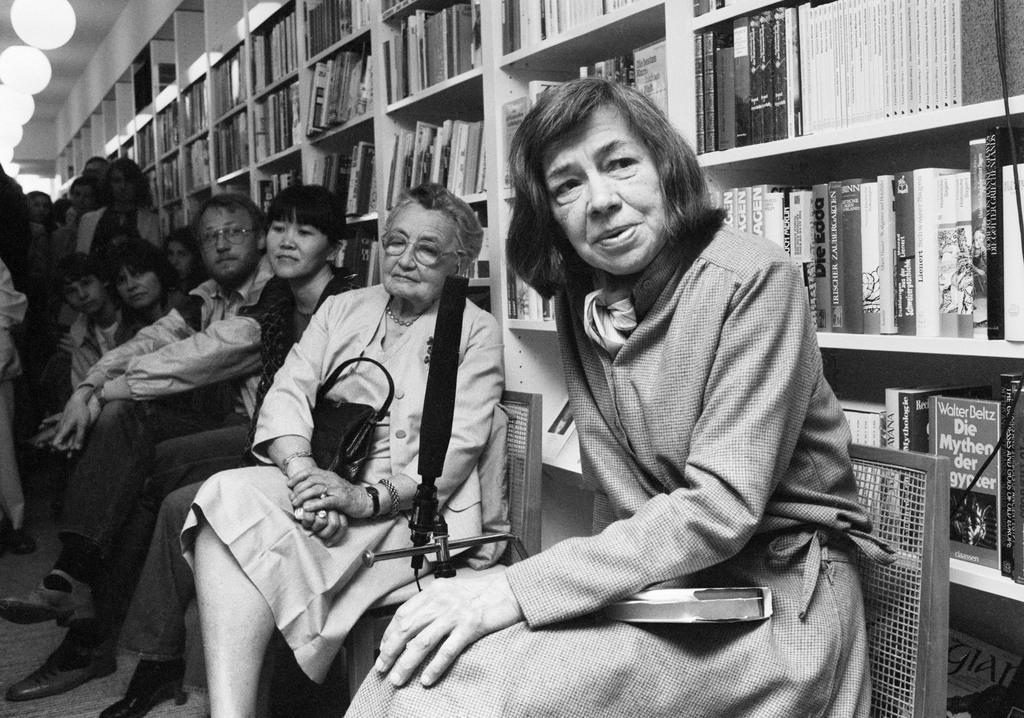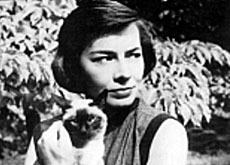Mountains that block the sun

The prolific American writer, Patricia Highsmith, spent the last 14 years of her life in the Italian-speaking canton of Ticino. Surprisingly, she set just one of her stories in the region.
Highsmith was able to paint a vivid picture of Ticino in the sentence that opens A long walk from hell: “It was, it is, a land of mountains that block the sun, a land of granite outcroppings, of trees that cling to the slanting hillsides but nevertheless grow straight up…”
She is believed to have written the story in the front room of the converted barn in the Maggia Valley hamlet of Aurigeno, her first home in Ticino.
“There’s no sun here at all between November and January and so it’s easy to imagine her writing the type of books she did,” says Jürg Scherz, who bought the house from Highsmith.
Some of the German versions of her novels line a shelf in the hallway, which Scherz purchased because he wanted to learn more about the reclusive writer whom he met only briefly during the property transaction.
Literary estate
Until her death in 1995, when she bequeathed her literary estate to the Swiss Literary Archives in Bern, little was known about the private Highsmith.
“We are only at the beginning of getting to know her as a person,” says Ulrich Weber, the archivist responsible for the Highsmith estate. “She didn’t talk much to the public about her life, but we now have many documents. She wrote diaries, notebooks, and lots of letters to friends, who knew her as a very complex person.”
One of those friends was the American expatriate, Vivien De Bernardi, who lives in a village only a few kilometres up the road from Aurigeno.
Like many Americans, De Bernardi had no previous knowledge of Highsmith, whose crime novels, including “Strangers on a Train” and the Ripley series, struck more of a chord in Europe than in the United States.
It was Highsmith who made contact with De Bernardi, having heard of her work with disabled children. Highsmith wanted her opinion of a story she was writing about a father of a handicapped child, who murders an innocent person out of sheer frustration.
The two women became close friends. They went to the cinema together in Locarno, and dined together at the Giardinetto restaurant in Tegna, where Highsmith spent the last years of her life.
But usually they just visited each other to discuss literature, Highsmith’s own work or chat about world affairs. De Bernardi said Highsmith read an international newspaper every day, but never paid any attention to local news or politics.
Tale of Ticino
That put the writer in a tight spot when the Paris-based newspaper, Le Monde, asked her to contribute a short story on Ticino. She turned to De Bernardi.
“My father-in-law was a great raconteur who had a story for every occasion,” De Bernardi remembers. “He would spin these marvellous tales of Ticino and the village in which we lived, and of the family. He gave me two or three ideas, and I repeated them to Pat.”
The result was A long way from hell, which tells the tragic story of a peasant excommunicated by the village priest over a property dispute. He sets off on foot for the long journey to the city to see the bishop.
The story also paints a vivid portrait of life in rural Ticino: “The story of Luigi’s walk to Lugano and back became known as Luigi’s pilgrimage to the bishop of Lugano. Then and to the end of his days, Luigi was not only the sole man in Riato to have seen Lugano; the fact that he had done it on foot elevated his adventure to the supernatural.”
The homage to the strength of the Ticinese peasant and happy ending were unusual for Highsmith, whose novels were once described by New Yorker magazine “as peerlessly disturbing bad dreams that keep us thrashing for the rest of the night…”
Evil
“She had a fascination with evil and guilt,” says Weber. “She was almost obsessed. She kept newspaper clippings reporting crimes.”
“She was very interested in the subject of evil,” agrees De Bernardi. “At the end of her life, after studying murderers, real and fictitious for her whole life, she came to the conclusion that what we call evil is essentially mental illness.”
De Bernardi says Highsmith suffered from depression and her outlook was generally bleak, but that her years living in small rural villages in Ticino were also her happiest.
“There’s a simplicity to the area and it has a tremendous natural beauty that, I think, paralleled the simplicity and beauty of her life.”
1921: Patricia Highsmith born in Fort Worth, Texas
1938-1942: Studied English literature at Columbia University, New York
1951-1953: Travelled through Europe
1960s-early 1980s: Lived in England and France
1982: Moved to Switzerland
1995: Died in a Locarno hospital
Highsmith published her first novel, Strangers on a Train, in 1950, which was, later made into a film. Several other novels were also filmed.
1955 saw the publication of The Talented Mr Ripley, a novel which made her world famous. In total she wrote 22 novels and many short stories.
After her death her literary estate was sold, in accordance with her wishes, to the Swiss Literary Archives.
(This story was first published in 2001.)

In compliance with the JTI standards
More: SWI swissinfo.ch certified by the Journalism Trust Initiative











You can find an overview of ongoing debates with our journalists here . Please join us!
If you want to start a conversation about a topic raised in this article or want to report factual errors, email us at english@swissinfo.ch.